

Why bother with mosses? One answer is suggested at the right, by the Common Bladder-moss, Physcomitrium pyriforme:
They're pretty and curious-looking. In fact, many people getting a good look at a moss can't avoid wondering if maybe there's something special about it. Well, the name Physcomitrium pyriforme can be looked up to find out.
 Common Bladder-Moss, Physcomitrium pyriforme, capsules with calyptras; image courtesy of Kristian Peters, via Wikimedia Commons
Common Bladder-Moss, Physcomitrium pyriforme, capsules with calyptras; image courtesy of Kristian Peters, via Wikimedia CommonsThe species' Wikipedia page quickly informs us that Common Bladder-moss is native to all parts of the world except South America and Antarctica. Its spore-producing capsules, shown at the left, mature from late fall through the next spring, and the species mostly occurs in wet, disturbed soils. That sounds right because the moss photographed above grew on naked dirt atop an old mole hill in a neglected lawn in February!
Reading that, we can visualize what's special about this moss. When something disturbs (damages) wet soil, this moss rushes in to form a kind of cover that keeps the soil from eroding away. The Common Bladder-moss is one of those good "first responder" citizens who turn up when disaster strikes.
MOSS DIVERSITY
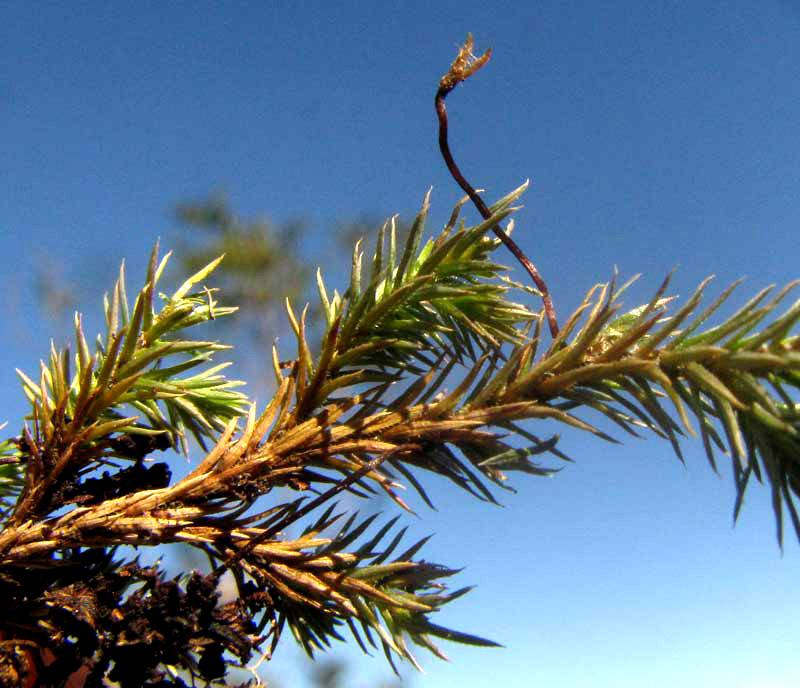
There's amazing diversity among the 12,000 or so known moss species. For example, in contrast to the Common Bladder-moss's affinity for wet, disturbed soil and nearly worldwide distribution, the Serrate Ptychomitrium Moss, Ptychomitrium serratum, at the right is a tough, wiry, branching species photographed on a bone-dry limestone rock in a hillside liveoak forest in hot, semiarid southwestern Texas. It's been documented in Texas, Louisiana, South Carolina, Mexico, and the Dominican Republic, mostly on limestone but also concrete and an old asphalt shingle roof in Louisiana.
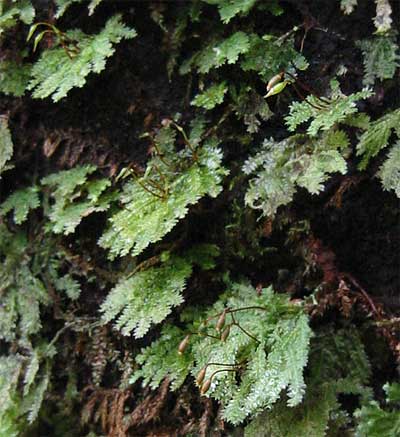
Yet completely different from the above two species is the unidentified fan-shaped moss at the left, possibly the Fern Moss, Thuidium delicatulum, or thereabouts, growing in a high-elevation, fog-soaked cloudforest in southern Mexico.
In fact, you can say that mosses are as diverse as the ecosystems and microecosystems available for them to occupy, and that amounts to a lot of ways mosses can look and behave.
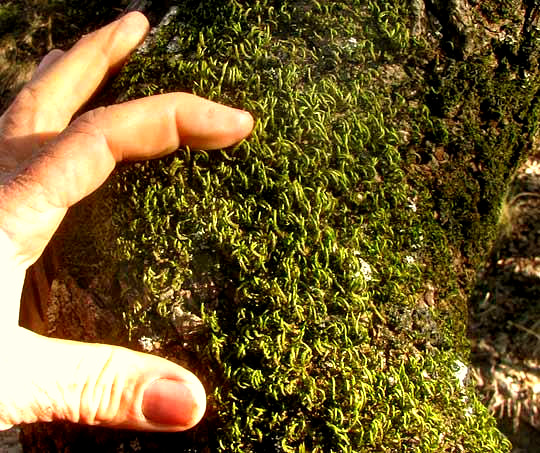
To further emphasize the point, at the right there's yet another species looking and behaving very different from the three previous ones. It's the Common Thelia Moss, Thelia hirtella, mostly inhabiting tree trunks in most of eastern North America south into northeastern Mexico and the Caribbean area.
HOW TO LOOK AT A MOSS
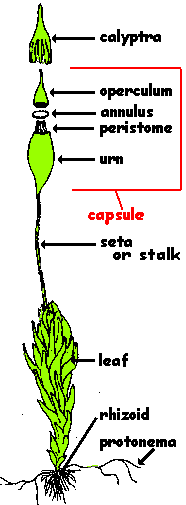
You can't begin appreciating moss diversity until you know what to look for. During the identification process, you'll learn what to see. Exactly as with flowering plants, nothing about the moss is more important to notice and admire than its reproductive structures. With flowering plants, that's the flower; with mosses, it's the calyptra-topped capsule, where reproductive spores are produced.
At the right you can see that the capsule stands atop a seta, or stalk, arising from the moss body. It consists of several parts, and it and its calyptra can vary a great deal in appearance.

At the left, a real calyptra-topped capsule is shown of the Isopterygium Moss, Isopterygium tenerum. The capsule is brown and nods downward atop its vertical stalk. In moss lingo, a nodding capsule is said to be "cernuous." When the capsule is ready to release its spores, the operculum comes off and spores escape through a hole in the capsule's top. One slightly unusual, thus important to notice feature of this capsule is that its top constricts just below its attachment with the operculum.
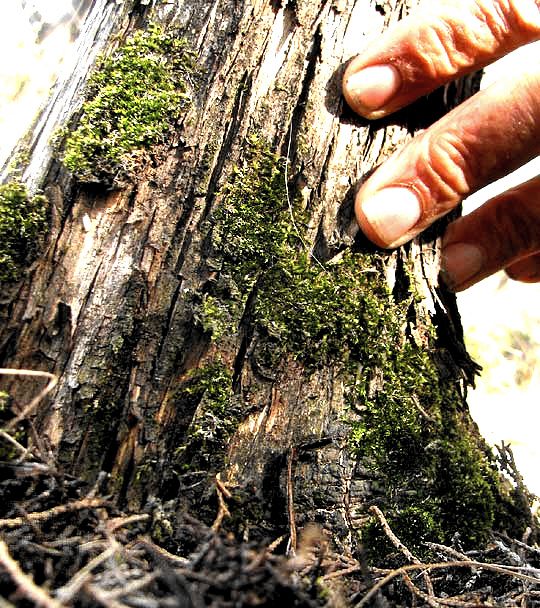
The above is how the Isopterygium Moss might be seen with the eyes. To see that species with the mind, which at first looks fairly bland in its habitat at the right, once the identification is accomplished, the name, Isopterygium tenerum, is looked up. The online Bryophyte Flora of North America's Isopterygium tenerum page describes the Isopterygium Moss as occupying dry, wooded regions, swamps and wet roadside ditches, rotten logs, stumps, bases of trees, sandy soil, and rarely on sedimentary rock, so this is a very adaptable species. It's also widespread, occurring in much of eastern North America, south into South America, the West Indies, and in Italy. It's described as one of the most common mosses in Central Florida.
And that's "seeing the Isopterygium Moss with the mind."
MOSS IDENTIFICATION
The above picture of the Isopterygium Moss in its habitat shows something important about mosses in the field: To see most of their ID features you need strong magnification.
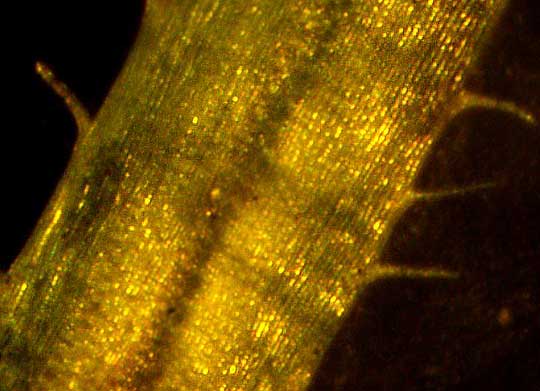
Sometimes a hand lens or jeweler's loupe will do but a microscope is very useful, sometimes critical. At the left, a microscopic view of a leaf of the Serrate Ptychomitrium Moss, Ptychomitrium serratum shows that the leaf margins bear spiny teeth, a midrib or "costa" runs down the leaf's middle, and cells are all more or less blocky and of the same size. Probably a hand lens would have seen the spiny teeth but ,maybe not the other features.
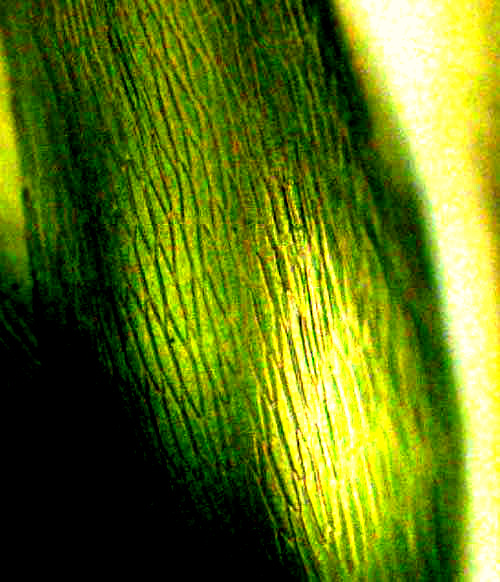
Cell shape and arrangement is very important for moss ID. Look how different the above Serrate Ptychomitrium Moss's blocky leaf cells are from those of the Isopterygium Moss at the right.
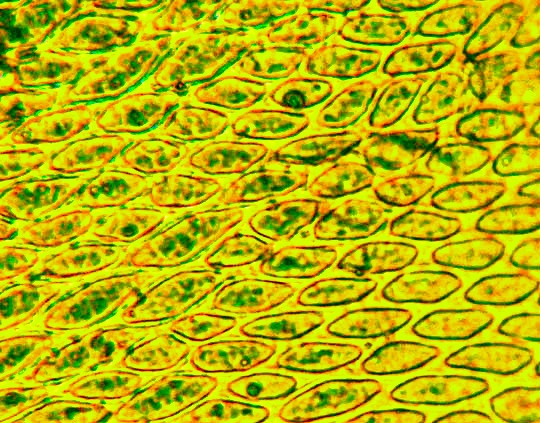
And how different the rice-grain-shaped cells of the Common Thelia Moss, Thelia hirtella, shown at the left, are from both of the above cell shapes.
ONE STEP AT A TIME

On the Flora of North America's Hyophiladelphus agrarius page, for the Barbula Moss shown at the left, we learn the following: The species' red-brown seta, which is twisted clockwise proximally, arises from amid the densely rhizoidiferous moss body's interior perichaetial leaves, which are occasionally weakly serrulate near the apex.
In other words, moss keys are full of terms and concepts that need to be learned.
The good news is that when you run into an unknown term, you can look up the term's meaning. Once you understand it, then go to the next term that stumps you, and look it up, too. Just keep leapfrogging from definition to definition until it all comes together, maybe days or months later. But, that's good, because this whole business of paying close attention to Nature feels good! Just try it.
One step at a time.
MOSS REPRODUCTION
If a moss gets broken into pieces, the leaves and stems can form new plants with the same genetic makeup as the mother plant. This is asexual or vegetative reproduction. Sexual reproduction is more complicated.

Moss plants can have both male structures, called antheridia, and female structures, called archegonia, on the same plant or, more often, on different plants.
Male antheridia produce sperm which swim to the female parts in water. Usually antheridia are hard to see, but in some species they're collected in "splash cups" atop the moss, as shown at the left, on an otherwise unidentified Mnium moss. When raindrops fall into the cup, they splash sperm to where there may be receptive moss archegonia.
From the archegonia, the seta or stalk arises atop which the capsule forms, filled with spores. Spores are spread by wind, rain and other ways. When they germinate, a green, thread-like protonema emerges, grows, forms different moss-body features, and finally new moss plants are formed.
MORE INFO
On the Web, check out these sites: